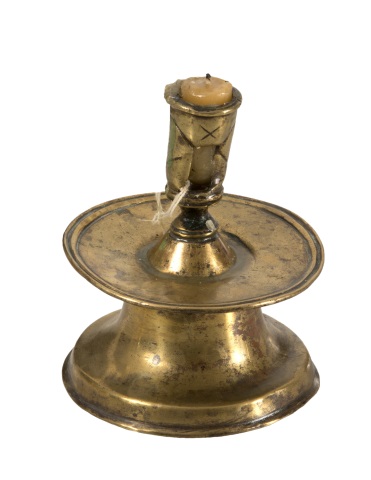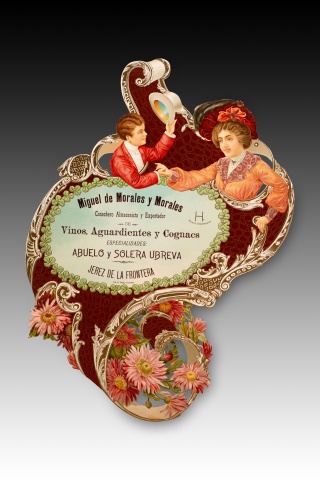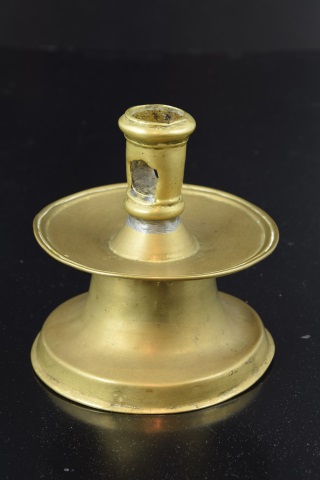
-
Devotional medal, Saint James the Apostle. Gilt bronze. 17th century. Openwork devotional medal with the image of Saint James the Apostle in the centre, on a pedestal and holding a staff and a book, surrounded by a wreath of leaves tied with two bows above and below. Similar examples can be found in the Museum of Pilgrimages in Santiago de Compostela.
· Size: 5x0.5x6 cms.
ANTIQUES
MISCELLANEUS;JEWELRY
Ref.: Z5091
-
Sold

Bronze Candlestick 16th century
· Size: 10,5x10,5x12 cms.
ANTIQUES
MISCELLANEUS;OTHER OBJECTS
Ref.: Z5735
-
Wall-mounted holy font. Bronze. Spain, 17th century. Small font for holy water designed to be placed on a wall, which has a container decorated with mouldings and architectural elements and a plaque, at the top, cut out with plant and architectural elements highlighting two angels with elements of the Passion and an image of the Virgin Mary (with iconography of the Immaculate) with the Child Jesus.
· Size: 7,5x9x22 cms
ANTIQUES
MISCELLANEUS;OTHER OBJECTS
Ref.: ZF0928
-
Triangular spice rack. Glazed ceramic. Talavera de la Reina, Spain, 17th century. It has damage. Triangular spice rack made of glazed ceramic decorated with a relief element in the centre of the three fronts and a series of motifs painted in brown, yellow and green on the top and on these fronts. Typologically, this is a very common model in the workshops of Talavera de la Reina, although not exclusive to this centre.
· Size: 14x13x5 cms.
ANTIQUES
MISCELLANEUS;CERAMIC
Ref.: ZF0940
-
Coffee set. Enameled porcelain. Royal Vienna, Austria, early 20th century. With marks on the base of the pieces. Two cups broken. Enameled porcelain coffee set consisting of a tray, six cups and saucers, a sugar bowl with lid and a jug with lid. Although the classicist influence in the piece is clear (golden garlands, shapes, plant elements, colours, etc.), it is necessary to point out that the tray was inspired by the oil painting by George Sheridan Knowles in 1908 and entitled “Summer Pleasures on The River”. Royal Vienna is a certain style of porcelain related to the porcelain made in Vienna (Kaiserlich privilegierte Porcellain Fabrique) founded in 1718 by Claude du Paquier, an official of the imperial court in Vienna. It was closed in 1864, but its name was recovered by the Vienna Porcelain Factory Augarten in 1923.
· Size: 32x32x15 cms.
ANTIQUES
MISCELLANEUS;CERAMIC
Ref.: ZF1147
-
Advertising poster, Marín Brothers, Warehousemen and Exporters of Wines and Cognacs from Jerez de la Frontera. Cardboard. Berlin, first half of the 20th century. Casa Marín Hermanos was founded in 1896 by Vicente and José María, who had previously worked as traveling salesmen for sherry brands. They were awarded a Gold Medal at the 1896 Lugo Regional Exhibition. The specialties mentioned on the poster (Amontillado Tres Cortados and Los Dos Hermanos) are mentioned in the Reseña de Bodegas de Jerez by R. Mena y Sobrino (Jerez, Litografía Jerezana Vicario, 1900). The poster was printed by Manes & Co. of Berlin, Germany.
· Size: 32x0,1x49 cms
ANTIQUES
MISCELLANEUS;GRAPHIC WORK
Ref.: ZF135404
-
Advertising poster, J. Leña Rendón & Cia. Warehousemen and Exporters of Fine Wines and Cognacs, Jerez de la Frontera. Cardboard. Valencia, Spain, first half of the 20th century. Advertising poster printed in Valencia by Lit. S. Durá for the company J. Leña Rendón & Cia. Storers and Shippers of Fine Wines and Cognacs, Jerez de la Frontera, founded in 1885 and known at the time for Gayarre Cognac, among other specialties. It is mentioned in the Review of Jerez Wineries by R. Mena y Sobrino (Jerez, Lithograph by Jerezana Vicario, 1900).
· Size: 33x0,1x50 cms
ANTIQUES
MISCELLANEUS;GRAPHIC WORK
Ref.: ZF135405
-
Advertising poster, Pedro Simó, Jerez de la Frontera. Cardboard. Berlin, first half of the 20th century. Advertising poster printed in Berlin, Germany, by Manes & Co., for the Spanish fine wine company Pedro Simó, located in Jerez de la Frontera. It is mentioned in the Statutes of the Guild of Breeders and Exporters of Jerez de la Frontera Wines (Jerez, Typographic Workshops: Plaza del Carmen, 1, 1921). #inbti#POSTER, PEDRO SIMÓ, JEREZ DE LA FRONTERA. CARDBOARD. BERLIN, FIRST HALF 20TH CENTURY.
· Size: 33x0,1x50 cms
ANTIQUES
MISCELLANEUS;GRAPHIC WORK
Ref.: ZF135406
-
Advertising poster, Goytia Brothers, Wine Growers, Warehousemen, and Exporters, Jerez de la Frontera. Cardboard. Berlin, first half of the 20th century. Advertising poster for Goytia Hermanos, Wine Growers, Warehousemen, and Exporters, Jerez de la Frontera. The company was founded in 1834 and had the distinction of selling its products only in Jerez, later developing a brisk trade both in the rest of Spain and abroad. It is mentioned in the Review of Jerez Wineries by R. Mena y Sobrino (Jerez, Litografía Jerezana Vicario, 1900). This advertising piece was produced by Prager & Lojda (Berlin SW), a printing house founded in the 19th century that produced numerous promotional products for Spanish companies during the first half of the 20th century.
· Size: 33x0,1x39 cms
ANTIQUES
MISCELLANEUS;GRAPHIC WORK
Ref.: ZF135407
-
Advertising poster, Bme Vergara y Quesada, Jerez de la Frontera, Electra wine. Cardboard. Berlin, first half of the 20th century. It shows damage. Advertising poster for the company (perhaps Bartolomé) Vergara y Quesada of Jerez de la Frontera, which emphasizes Electra wine by adding a telegram in the hands of the man depicted. It was produced by the Kunstdruck Friedberg workshop in Berlin.
· Size: 47x0,1x40 cms
ANTIQUES
MISCELLANEUS;GRAPHIC WORK
Ref.: ZF135408
-
Advertising poster, Pomar y Reyes, Exporters of Wines, Cognac, and Spirits, Jerez de la Frontera. Cardboard. Berlin, first half of the 20th century. There is evidence of the existence of Pomar y Reyes on Zaragoza Street in Cádiz (page 2001, Yearbook of Commerce, Industry, Judiciary and Administration: (Bailly, Baillière, Riera), volume 1910). The poster was made in Berlin (Germany) by the Kunstdruck Friedberg workshop.
· Size: 51x0,1x40 cms
ANTIQUES
MISCELLANEUS;GRAPHIC WORK
Ref.: ZF135411
-

Advertising poster, Miguel de Morales y Morales (etc.), Jerez de la Frontera. Cardboard. Valencia, first half of the 20th century. Advertising poster made in Valencia by Lit. S. Durá for, as the text indicates, “Miguel de Morales y Morales, / Grower, Warehouseman and Exporter / of / Wines, Spirits and Cognacs / Specialties: / Abuelo and Solera Ubreva / Jerez de la Frontera), which was also a registered trademark. José Ubreva opened his wineries in 1800 for export, and ended up running the business, under his name, Miguel de Morales y Morales (Arcos, 1826), who married Caetana Ubreva Bardayo (1840-1920), inheriting these wineries. The company is mentioned in the Review of Jerez Wineries by R. Mena y Sobrino (Jerez, Litografía Jerezana Vicario, 1900). In the Statutes of the Guild Association of Breeders-Exporters of Jerez Wines from the Frontera (Jerez, Typographic Workshops: Plaza del Carmen, 1, 1921) Manuel de Morales is mentioned.
· Size: 37x0,1x53 cms
ANTIQUES
MISCELLANEUS;GRAPHIC WORK
Ref.: ZF135415
-
Advertising poster, Widow of José María de Morales, Fine Wines and Cognac, Jerez. Cardboard. Possibly Spain, first half of the 20th century. Advertising poster for the Casa Viuda de José María de Morales, highlighting its product with a very concise text (Fine Wines and Cognac / Jerez). José María de Morales, son of Miguel Morales and Cayetana Ubreva, owned a winery and died at the age of 38. His widow ran the business until 1909. There is evidence of a photograph entitled "Interior of the extraction and bottling cellar of the Casa Viuda de José María de Morales, Jerez, managed by Mr. Aureliano Valenzuela Pérez," dated January 6, 1908, which would have appeared in the newspaper ABC.
· Size: 37x0,1x51 cms
ANTIQUES
MISCELLANEUS;GRAPHIC WORK
Ref.: ZF135416
-
Advertising poster, José María de Morales, Wine Exporter, Jerez. Cardboard. Berlin, first half of the 20th century. It has some marks. Miguel Morales y Morales (Arcos 1826) and Cayetana Ubreva Bardayo (1840-1920) were the parents of José María de Morales, who had nine siblings and a winery mainly used for storage on Ávila Street in Jerez. He was best known for the brandy called “Uno, Dos y Tres Racimos” and died at the age of 38, although his widow kept the business going until 1909. There is a record of a photograph entitled “Interior of the extraction and bottling winery of the widow's house of José María de Morales, Jerez, Directed by Mr. D. Aureliano Valenzuela Pérez”, dated January 6, 1908, which would have appeared in the newspaper ABC.
· Size: 30x0,1x53 cms
ANTIQUES
MISCELLANEUS;GRAPHIC WORK
Ref.: ZF135418
-
Advertising poster, Molina y Cia, Jerez de la Frontera, Exporters of wines, cognac-style spirits, and liqueurs. Cardboard. Berlin, first half of the 20th century. Advertising poster made in Berlin for the Molina y Cía. company. José María Molina y Lamata worked at Bodegas Misa before establishing his own winery in 1870, achieving great international success. In 1884, he joined forces with Servando Álvarez Algeciras, moving to Clavel Street, to a complex consisting of three wineries with the most notable technological innovations of the time. The company reached its peak between the late 19th and early 20th centuries. José María Molina died around 1908, and Servando bought the house, later selling it to Emilio Hidalgo.
· Size: 25x0,1x42 cms
ANTIQUES
MISCELLANEUS;GRAPHIC WORK
Ref.: ZF135422
-
Advertising poster, J. Leña Rendon y Cia., Warehousemen and Exporters of Wines and Cognacs, Jerez de la Frontera. Cardboard. Berlin, first half of the 20th century. Poster made in Berlin, Germany, by Manes & Co. J. Leña Rendón & Cia. was founded in 1885 and was known at the time for Gayarre cognac, among other specialties. It is mentioned in the Review of Jerez Wineries by R. Mena y Sobrino (Jerez, Litografía Jerezana Vicario, 1900).
· Size: 34x0,1x30 cms
ANTIQUES
MISCELLANEUS;GRAPHIC WORK
Ref.: ZF135427
-
Poster, Aurora Insurance Company. Cardboard. Spain, first half of the 20th century. Seguros Aurora was a company founded on February 13, 1900, promoted by individuals associated with the shipping and mining industries, with the primary objective of focusing on marine insurance. The Bilbao coat of arms appears on the poster, as does another one, also visible on the Ermua coat of arms. Mention can also be made of the printing house responsible for the work, Reclamos Vilaró of Barcelona, known for other Spanish advertisements and advertising claims dating back to around the 1920s.
· Size: 27x0,1x40 cms
ANTIQUES
MISCELLANEUS;GRAPHIC WORK
Ref.: ZF135434
-
Carved silver box, 20th century. Small silver box carved with a wide variety of motifs, all belonging to different artistic traditions based on Roman classicism. On the lid, two musicians appear framed in a decoration made up of figures and plant and architectural elements. The front shows garlands of flowers and leaves and scroll shields. The base is decorated with scallops, flowers and plant elements. These types of pieces were used to store various objects, and were usually carried or left on the dressing table, belonging in all cases to people of importance due to the quality of the work and the material with which they were made. Weight: 300 gr
· Size: 11,5x6,5x4 cms.
ANTIQUES
MISCELLANEUS;SILVER
Ref.: Z0327
-
Special Offer! - Off

Candlestick, 16th century In bronze. Polished bronze candlestick with a wide circular base from which a conical stem rises, opening into a smooth plate that holds the candle holder. This Renaissance-era candlestick is of a simple design, with no ornamentation except for the delicate molding on the plate.
· Size: 10x10x10 cms.
ANTIQUES
MISCELLANEUS;OTHER OBJECTS
Ref.: Z5751B
-
Serving cutlery in a case. Silver, gilt silver, textile, etc. Puiforcat, France, circa 1900. With contrast marks. Pair of serving cutlery with a silver handle in its colour and the other part gilded, decorated with engraved and embossed elements in the neoclassical tradition, and openwork areas with plant elements. Émile Puiforcat, when he took over his uncle's company, registered the hallmark that the firm still uses today (a knife flanked by the letters E and P). The rectangular case, with clasps at the front, features a strip referring to a Brussels jewellery and goldsmith's shop called De Coster Paternoster (located at 128 rue Royale), which sold notable pieces such as diamond earrings, cufflinks, etc. Weight: 296 grams.
· Size: 5x1,5x32 cms
ANTIQUES
MISCELLANEUS;SILVER
Ref.: ZF1309
-
Oriental figure. Hard stones. 20th century. Stylized figure made of dark-colored hard stone, with some veins in lighter colors, which perhaps represents one of the Eight Immortals of the Taoist pantheon, specifically He Xiangu (who is usually shown holding a lotus flower, sometimes also accompanied by a sheng, or by a mythological bird called fenghuang).
· Size: 4,5x3x16 cms.
ANTIQUES
MISCELLANEUS;OTHER OBJECTS
Ref.: Z6142B
-
Poster, Seville Bullring. Printed paper, framed. Seville, 1877. It has faults. Poster made by the printing house located on Juan de Burgos Street (today Fernán Caballero Street) for the bullfight on November 25, 1877, in the so-called "Plaza de Toros de Sevilla" (Seville Bullring), currently better known as the Maestranza, which was completed in 1876 by the architect Juan Talavera de la Vega.
· Size: 74x4x58 cms
ANTIQUES
MISCELLANEUS;GRAPHIC WORK
Ref.: ZF135402
-
Bullfighting poster. Printed paper, framed. Seville, Spain, circa the second half of the 19th century (1844). It has faults. Bullfighting poster (note the handwritten annotation with the month of May) for a bullfight scheduled for the afternoon of Monday the 12th of the current month at the Seville Bullring, better known today as the Maestranza. Another similar poster, dated 1844, is known to be preserved in a private collection there, thanks to a newspaper article (Diario de Sevilla, Sunday, October 29, 2000, “Romero debuted at La Pañoleta,” “The Bullfighting Fair of 1847”).
· Size: 74x4x58 cms
ANTIQUES
MISCELLANEUS;GRAPHIC WORK
Ref.: ZF135403
-
Advertising poster, J. Leña-Rendón & Cia. Wine and Cognac Exporters, Jerez de la Frontera. Cardboard. Possibly Spain, first half of the 20th century. It has marks. Advertising poster for the company J. Leña Rendón & Cia. Storers and Shippers of Fine Wines and Cognacs, Jerez de la Frontera, founded in 1885 and known at the time for Gayarre Cognac, among other specialties. It is mentioned in the Review of Jerez Wineries by R. Mena y Sobrino (Jerez, Lithograph by Vicario, 1900).
· Size: 38x0,1x33 cms
ANTIQUES
MISCELLANEUS;GRAPHIC WORK
Ref.: ZF135414